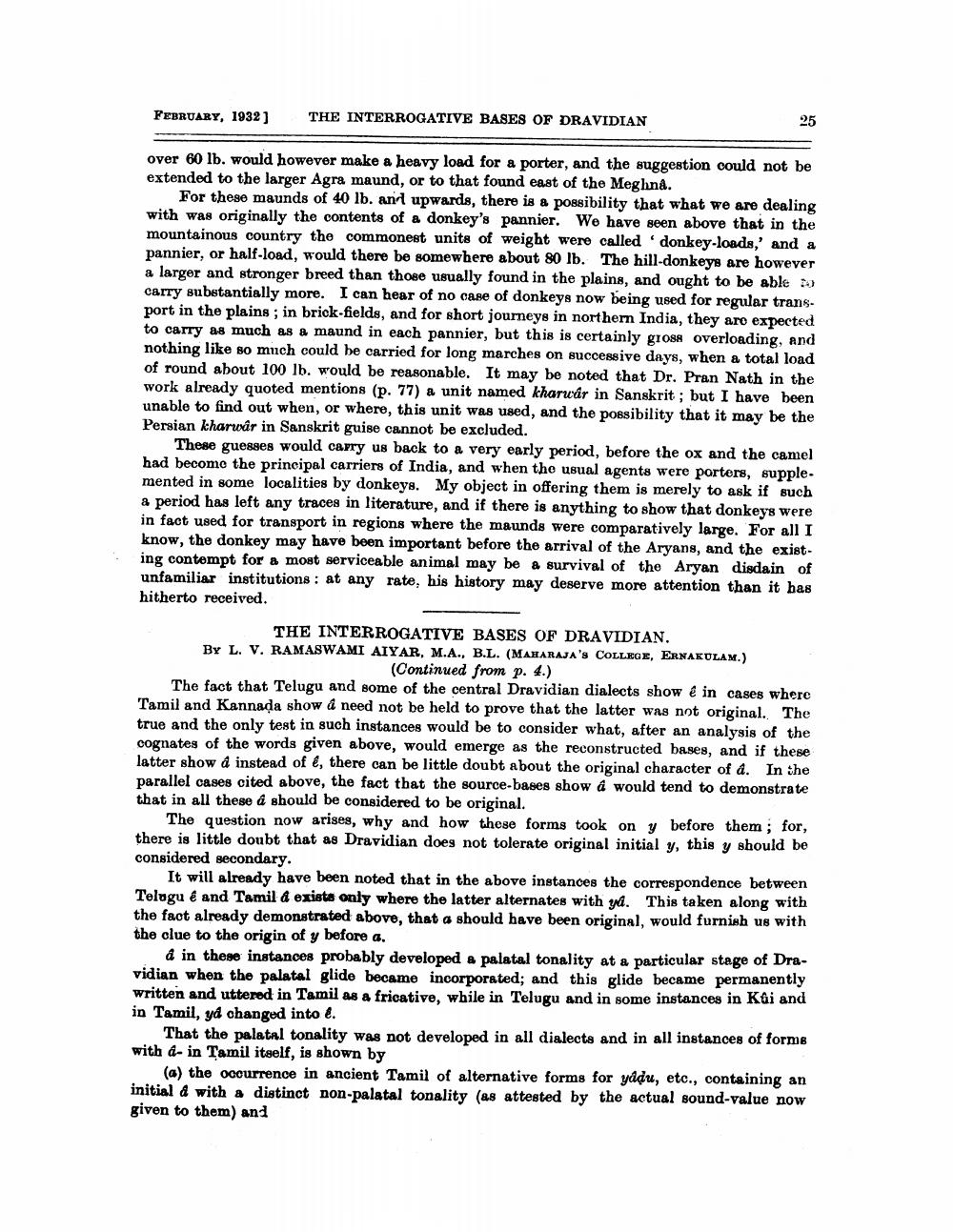________________
FEBRUARY, 1932)
THE INTERROGATIVE BASES OF DRAVIDIAN
over 60 lb. would however make a heavy load for a porter, and the suggestion could not be extended to the larger Agra maund, or to that found east of the Meghna.
For these maunds of 40 lb. an upwards, there is a possibility that what we are dealing with was originally the contents of a donkey's pannier. We have seen above that in the mountainous country the commonest units of weight were called 'donkey-loads,' and a pannier, or half-load, would there be somewhere about 80 lb. The hill-donkeys are however a larger and stronger breed than those usually found in the plains, and ought to be able to carry substantially more. I can hear of no case of donkeys now being used for regular transport in the plains; in brick-fields, and for short journeys in northern India, they are expected to carry as much as a maund in each pannier, but this is certainly gross overloading, and nothing like so much could be carried for long marches on successive days, when a total load of round about 100 lb. would be reasonable. It may be noted that Dr. Pran Nath in the work already quoted mentions (p. 77) a unit named kharuár in Sanskrit ; but I have been unable to find out when, or where, this unit was used, and the possibility that it may be the Persian kharwar in Sanskrit guise cannot be excluded.
These guesses would capry us back to a very early period, before the ox and the camel had become the principal carriers of India, and when the usual agents were porters, supple. mented in some localities by donkeys. My object in offering them is merely to ask if such & period has left any traces in literature, and if there is anything to show that donkeys were in fact used for transport in regions where the maunds were comparatively large. For all I know, the donkey may have been important before the arrival of the Aryans, and the existing contempt for a most serviceable animal may be a survival of the Aryan disdain of unfamiliar institutions : at any rate, his history may deserve more attention than it has hitherto received.
THE INTERROGATIVE BASES OF DRAVIDIAN. By L. V. RAMASWAMI AIYAR, M.A., B.L. (MAHARAJA'S COLLEGE, ERNAKULAM.)
(Continued from p. 4.) The fact that Telugu and some of the central Dravidian dialects show é in cases where Tamil and Kannada show a need not be held to prove that the latter was not original. The true and the only test in such instances would be to consider what, after an analysis of the cognates of the words given above, would emerge as the reconstructed bases, and if these latter show a instead of e, there can be little doubt about the original character of a. In the parallel cases cited above, the fact that the source-bases show a would tend to demonstrate that in all these d should be considered to be original.
The question now arises, why and how these forms took on y before them; for, there is little doubt that as Dravidian does not tolerate original initial y, this y should be considered secondary.
It will already have been noted that in the above instances the correspondence between Telugu & and Tamil & exista only where the latter alternates with w. This taken along with the fact already demonstrated above, that a should have been original, would furnish us with the clue to the origin of y before a.
& in these instances probably developed a palatal tonality at a particular stage of Dravidian when the palatal glide became incorporated; and this glide became permanently written and uttered in Tamil as a fricative, while in Telugu and in some instances in Kai and in Tamil, yd changed into &.
That the palatal tonality was not developed in all dialects and in all instances of forme with &- in Tamil itself, is shown by
(a) the occurrence in ancient Tamil of alternative forms for yddu, etc., containing an initial d with a distinct non-palatal tonality (as attested by the actual sound-value now given to them) and




